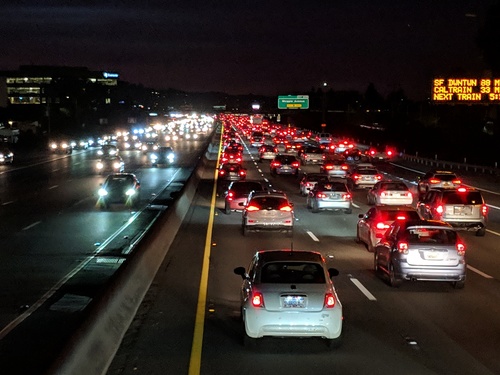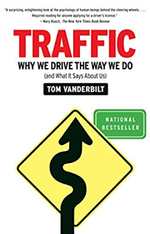Traffic I: Why is the Other Lane Always Faster?
Contents
“This highway has four lanes. One of them is the fastest, and there’s a 75% chance we’re not in it."
Last year, I switched from the Google office in San Francisco, next to where I live, to the Mountain View office. In search of more interesting projects and better career prospects, I repeated the move towards the company headquarters many engineers make. But it comes with a price. The 101.
The commute takes anywhere between 45 minutes and 2 hours one way. The spread is not a force of nature; it is completely explained by the variations in traffic.
Series on Car Traffic modeling
Inspired by my almost daily commute on California Highway 101, I explored the achievements of traffic theory and found answers to the most pressing mysteries of my commute.
The more time I spent on the road, the more I noticed that the traffic follows some predicatable patterns. I noticed the patterns but they seemed counterintuitive. For example:
- Why does the left lane travels faster when the road is clear but seems to get stuck more when there’s traffic? (here’s why)
- Why does the 92-101 southbound interchange always gets stuck but the road is always free after that? (here’s why)
- And finally, why are other lanes always faster?
Over the next several posts, I plan to explore these questions and maybe build some sort of a traffic simulator. But let’s begin?
“Why are other lanes always faster?”
Once I was late for a flight, and a colleague offered to drive me so I wouldn’t have to spend time on parking. It was a Thursday afternoon so the Bay Area traffic was in a predictable standstill. Luckily, my colleague was an amateur race car driver, so we gave it a shot.
Racing expertise didn’t seem to help. Some skills were helpful, like merging at will into a lane that has “no space” between the cars. However, we got predictably stuck with the rest of the drivers. We started talking about traffic, and why did we get stuck in the slowest lane.
I brought up a book on traffic that I listened to before. “Traffic: Why We Drive the Way We Do (and What It Says About Us) by Tom Vanderbilt is a very fitting enterntainment for someone stuck in their car (I listened to it on Amzaon’s Audible). Among other mysteries of traffic, the book explored the paradox of the slowest lane, in the very first chapter.
So why do other lanes seem faster? The book posits that it’s an illusion: (the other lanes are just as slow), and offers the following explanation:
- “Unoccupied waiting” seems longer than it actually is.
- Humans hate when others “get ahead of them”.
- We’re naturally more aware of things that move than of the things that don’t, so we don’t notice the other lane when it’s slow.
Having heard all that, my colleague offered a simpler explanation.
“This highway has four lanes. One of them is the fastest, and there’s a 75% chance we’re not in it."
Let’s make a model!
And I think my friend was more accurate here. Traffic lanes do differ in the time it takes to travel them. I kept noticing that when driving down the highway in the left lane and as the traffic “bunched up” way further back than the “slower” right lanes!
That’s why I want to come up with a mathematical model that explains my own commute experience. Here, I will not take on modelling traffic in a big, densely interconnected city, but focus on something simpler. I’ll try to model the traffic on one single long highway (just like the 101), and see where it takes me.
Of course there will be lanes, because explaining the dissimilarity between the flow of traffic in different lanes is the whole goal of this.
Stay tuned.


